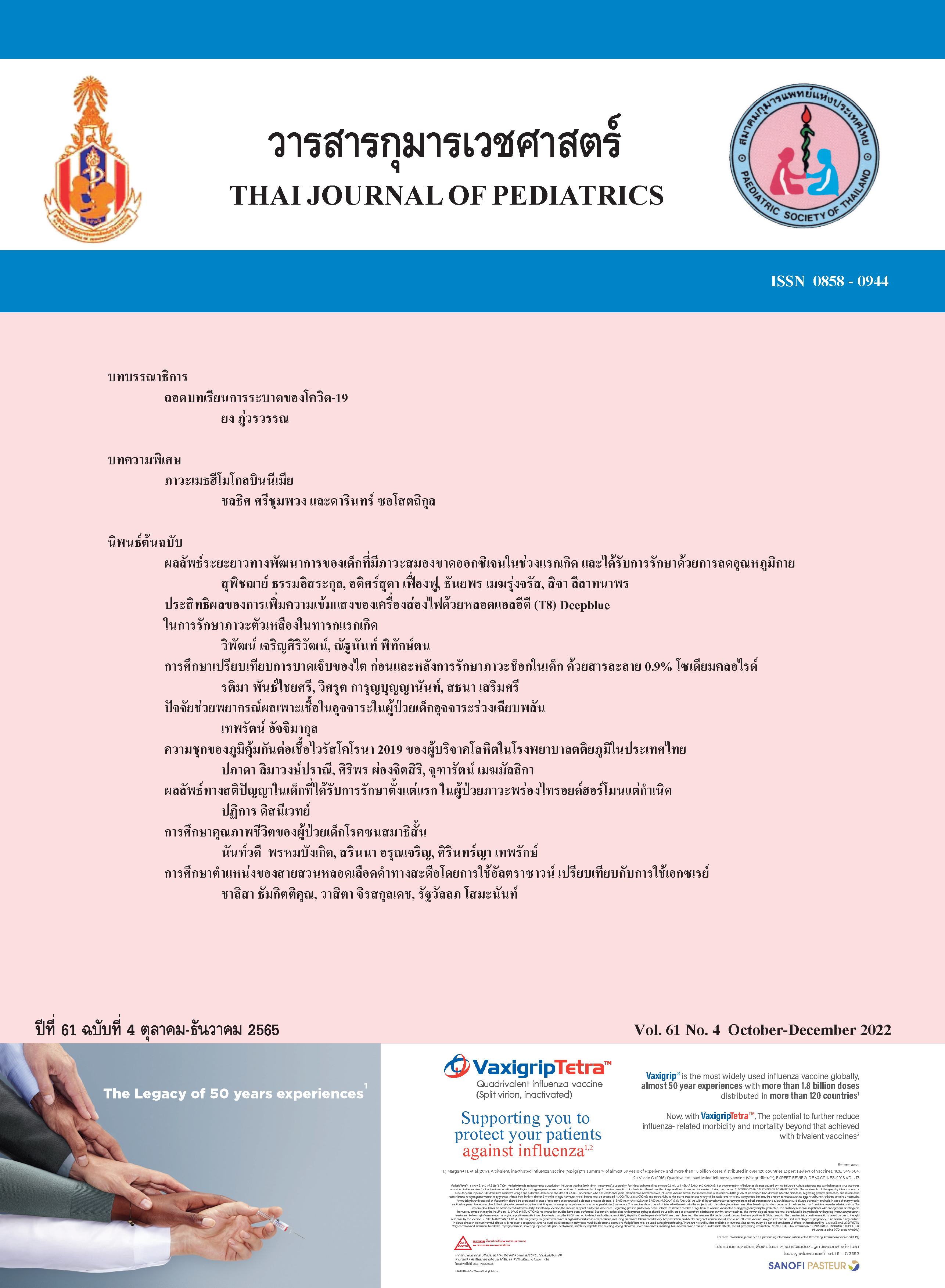ปัจจัยช่วยพยากรณ์ผลเพาะเชื้อในอุจจาระในผู้ป่วยเด็กอุจจาระร่วงเฉียบพลัน
คำสำคัญ:
clinical feature, stool culture, acute diarrheaบทคัดย่อ
หลักการและเหตุผล: ปัญหาอุจจาระร่วงเฉียบพลันเป็นภาวะที่พบได้บ่อยในผู้ป่วยเด็ก โดยการตรวจพบเชื้อในอุจจาระในผู้ป่วยเด็กที่อุจจาระร่วงเฉียบพลันมีโอกาสได้ผลบวกน้อยและใช้เวลานาน ผู้ป่วยบางส่วนจึงได้รับยาปฏิชีวนะโดยไม่จำเป็น
วัตถุประสงค์: เพื่อหาแนวทางในการประเมินโดยใช้อาการ/อาการแสดงและผลการตรวจทางห้องปฏิบัติการในการช่วยพยากรณ์โอกาสตรวจพบเชื้อในอุจจาระ
วิธีการศึกษา : การศึกษาข้อมูลแบบย้อนหลังในผู้ป่วยที่อุจจาระร่วงเฉียบพลัน อายุ 1 เดือนถึง 15 ปี ที่เข้ารับการรักษาที่โรงพยาบาลหาดใหญ่ตั้งแต่ 1 มกราคม 2560 ถึง 31 ชันวาคม 2563 ใช้การวิเคราะห์แบบ logistic regression และ prediction model จาก ROC curve
ผลการศึกษา : จากการศึกษานี้พบว่ามีผู้ปวยที่ได้รับการส่งเพาะเชื้อในอุจจาระ 758 ราย และตรวจพบเชื้อในอุจจาระ 155 ราย (ร้อยละ 20) โดยเชื้อก่อโรคที่พบมากที่สุด คือ Salmonella spp. (ร้อยละ 80) พบว่าปัจจัยที่สัมพันธ์กับการพบเชื้อในอุจจาระด้วยการวิเคราะห์ mulivariable ได้แก่ อายุน้อยกว่า 12 เดือน (OR 3.18 95% CI: 1.78 5.66, p-value <0.00 1), ถ่ายมากกว่า 5 ครั้งใน 24 ชั่วโมง(OR 2.6. 95% CI: 1.45-4.68,p-value 0.00 1), พบเม็ดเลือดขาวในอุจจาระ (OR 6, 95% CI: 3.35-10.73, p-value <0.001), ไม่มีอาการร่วมอื่นๆ (OR 2.03, 95%CI: 1.11-3.69, p-value 0.019), ไม่มีภาวะขาดน้ำระดับปานกลางขึ้นไป (OR 2.06, 95% CI: 1.14-3.73 p-value 0.015) มีความสัมพันธ์กับการพบเชื้อในอุจจาระ และเมื่อ
นำปัจจัยดังกล่าวมาทำ prediction model พบว่าถ้าคะแนนรวมมากกว่า 9 คะแนนจาก 15 คะแนน จะมีโอกาสตรวจพบเชื้อในอุจจาระ โดยมีความไวร้อยละ 59 และความจำเพาะร้อยละ 84
สรุปผลการศึกษา : การนำปัจจัยที่สัมพันธ์กับการพบเชื้อในอุจจาระมาเป็นเครื่องมือช่วยในการพยากรณ์โอกาสการพบเชื้อในอุจจาระ จะช่วยลดการส่งตรวจและการให้ยาปฏิชีวนะทีไม่จำเป็น
Downloads
เอกสารอ้างอิง
แผนงานวิจัยด้านการป้องกันควบคุมโรคและภัยสุขภาพ พ.ศ.2562-2564กรมควบคุมโรคกระทรวงสาธารณสุข.
Bodhidatta L, Vithayasai N, Eimpokalarp B, et. al. Bacterial enteric pathogens in children with acute dysentery in Thailand: increasing importance of quinolone-resistant Campylobacter. Southeast Asian J Trop Med Public Health. 2002;33:752-7.
Craven D, Brick D, O Riordan MA, et al. Low yield of bacterial stool culture in children with nosocomial diarrhea. Pediatr Infect Dis J. 1998: 17(11); 1040-4.
แนวทางเวชปฏิบัติการดูแลรักษาโรคท้องร่วงเฉียบพลันในเด็ก Clinical Practice Guideline forAcute Diarrheain Children พ.ศ.2562โดยสมาคมกุมารเวชศาสตร์ทางเดินอาหารและตับ
Li R, Xiao F, Zheng X, et al. Antibiotic misuse among children with diarrhea in China: results from a national survey. PeerJ 4: e2668; DOI 10.7717/peerj.2668.
Osatakul S, Puetpaiboon A. Appropriate use of empirical antibiotics in acute diarrhoea: a cross-sectional survey in southern Thailand. Annals of Tropical Paediatrics. 2007; 27: 115–122.
Devasia RA, Varma JK, Whichard J, et al. Antimicrobial use and outcomes in patients with multidrug-resistant and pansusceptible Salmonella Newport infections, 2002-2003.Microb Drug Resist. Winter 2005. 11;4:371-7.
Cadwgan AM, Watson WA, Laing S. RB, et al. Presenting clinical features and c-reactive protein in the prediction of a positive stool Culture in Patients with Diarrhoea. Journal of Infection. 2000;41:159–161.
Lee J, Cho S, Hae Hwang H, et al. Diagnostic yield of stool culture and predictive factors for positive culture in patients with diarrheal
illness. Medicine. 2017;96:30
Fenta A, Alemu K, Angaw DA, et al. Prevalence and associated factors of acute diarrhea among under-five childrenin Kamashi district, western Ethiopia: community-based study. BMC Pediatrics. 2020; 20: 236.
E d u s a d a - C o r p u s R . C l i n i c a l a n d laboratory predictors of bacterial diarrhea in a tropical environment. Military medicine. 1991;156: 74.
Finkelstein JA, Schwartz JS, Torrey S, et al. Common clinical features as predictors of bacterial diarrhea in infants. American Journal of Emergency Medicine. 1989;7:5.
Koplan JP, Fineberg HV, Ferraro MJ, Rosenberg ML. Value of stool cultures. Lancet. 1980; 2: 413-6.
Riaz MM, Patel MJ, Khan MS, et al. Clinical characteristics and predictors of positive stool culture in adult patients with acute gastroenteritis. J Pak Med Assoc. 2012;62:1
ดาวน์โหลด
เผยแพร่แล้ว
รูปแบบการอ้างอิง
ฉบับ
ประเภทบทความ
สัญญาอนุญาต

อนุญาตภายใต้เงื่อนไข Creative Commons Attribution-NonCommercial-NoDerivatives 4.0 International License.



